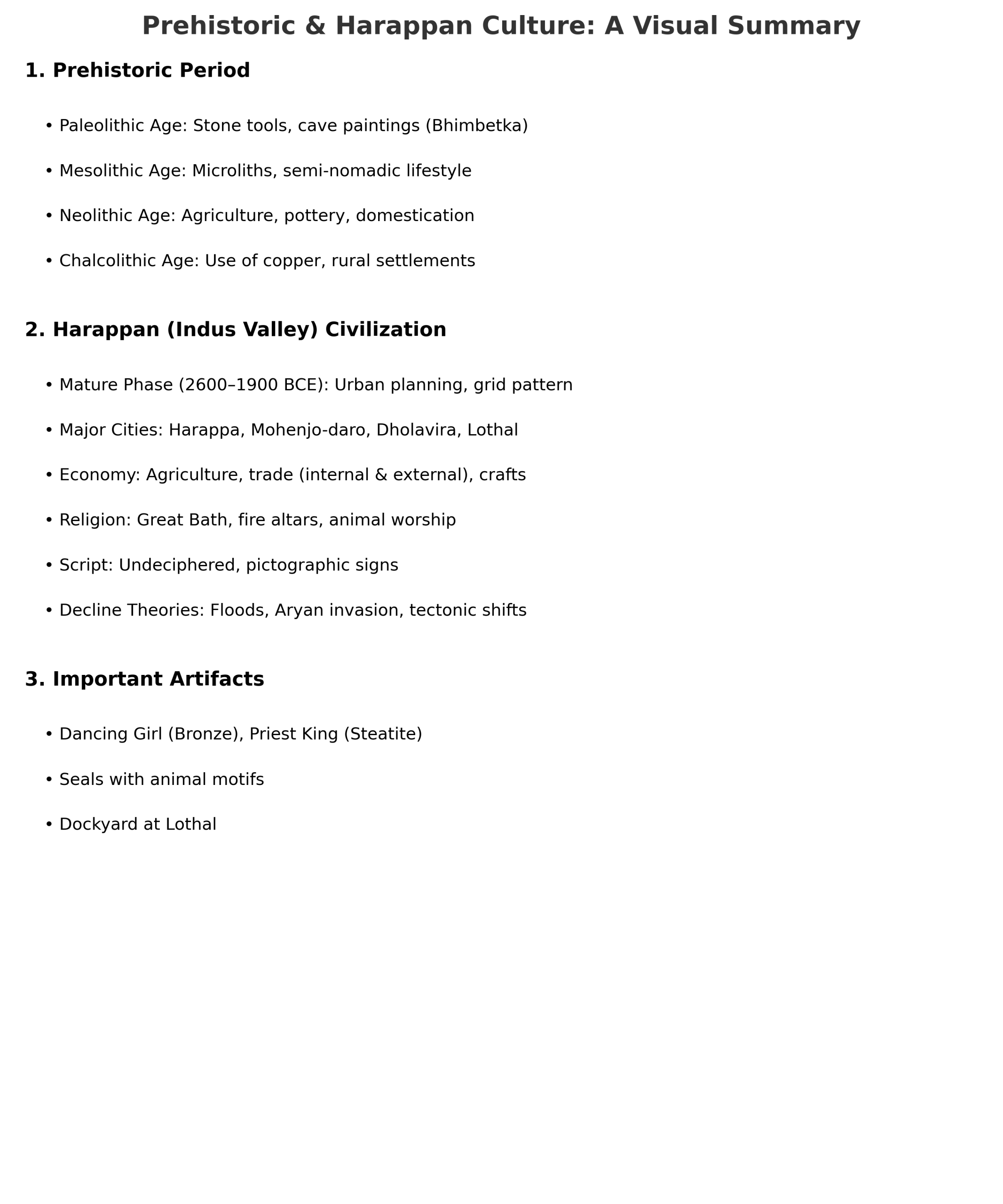
22 Jul Prehistoric & Harappan Culture
Prehistoric & Harappan Culture – UPSC History Optional Paper 1
Introduction
Understanding the evolution of human civilization from prehistory to the emergence of the Harappan Civilization is fundamental to Paper 1 of the UPSC History Optional syllabus. Prehistoric culture marks the beginning of human adaptation, technological progress, and social formation, while the Harappan (Indus Valley) Civilization represents the zenith of urban culture in Bronze Age India. These periods set the foundation for ancient Indian history.
1. Prehistoric Culture
Prehistory refers to the period before the invention of writing. It is primarily studied through archaeological remains. Based on tool-making technology and lifestyle, it is classified into the following stages:
Best history optional coaching in delhi
best history optional test series
a. Paleolithic Age (Old Stone Age)
- Time Period: Roughly 2 million BCE – 10,000 BCE
- Key Features:
- Use of crude stone tools and hand axes
- Hunter-gatherer lifestyle
- Use of caves and rock shelters (e.g., Bhimbetka in Madhya Pradesh)
- Discovery of fire
- Divided into:
- Lower Paleolithic: Acheulian tools
- Middle Paleolithic: Flake tools
- Upper Paleolithic: Blade tools, art objects
b. Mesolithic Age (Middle Stone Age)
- Time Period: 10,000 BCE – 6000 BCE
- Key Features:
- Microlithic tools
- Beginnings of domestication of animals
- Semi-nomadic life, seasonal camps
- Paintings depicting hunting, dancing, rituals (Bhimbetka)
c. Neolithic Age (New Stone Age)
- Time Period: 6000 BCE – 1000 BCE (varies regionally)
- Key Features:
- Domestication of animals and agriculture (wheat, barley)
- Permanent settlements (e.g., Burzahom in Kashmir, Mehrgarh in Baluchistan)
- Polished stone tools, pottery, community life
d. Chalcolithic Age
- Time Period: 3000 BCE – 1000 BCE
- Key Features:
- First use of copper tools along with stone tools
- Village settlements (Ahar, Jorwe, Malwa cultures)
- Distinctive painted pottery, fortified structures
2. Harappan Culture (Indus Valley Civilization)
The Harappan Civilization, also called the Indus Valley Civilization, represents the first urbanization phase in India. It flourished around the Indus River system.
a. Chronology and Phases
- Early Harappan (3300–2600 BCE): Pre-urban phase
- Mature Harappan (2600–1900 BCE): Peak urbanism
- Late Harappan (1900–1300 BCE): Decline phase
b. Major Sites
- Harappa (Punjab, Pakistan)
- Mohenjo-daro (Sindh, Pakistan): Great Bath, granaries
- Dholavira (Gujarat): Water reservoir system
- Lothal (Gujarat): Dockyard, trade evidence
- Kalibangan (Rajasthan): Fire altars, ploughed fields
c. Urban Planning and Architecture
- Grid pattern streets with right angles
- Advanced drainage and sanitation system
- Use of standardized burnt bricks
- Public structures: granaries, citadels, Great Bath
d. Economy and Trade
- Agriculture: Wheat, barley, dates, cotton
- Domesticated animals: Cattle, buffaloes, sheep
- Internal and external trade (Mesopotamia)
- Weights and measures (binary system)
e. Religion and Culture
- Worship of Mother Goddess, Proto-Shiva (Pashupati seal)
- Animal and tree worship (unicorns, pipal tree)
- Absence of clear temples
- Burial practices (extended inhumation, grave goods)
f. Art and Craft
- Bronze sculpture: Dancing Girl (Mohenjo-daro)
- Steatite sculpture: Priest King (Mohenjo-daro)
- Bead-making, pottery, seals, terracotta toys
g. Script
- Pictographic, undeciphered
- Mostly found on seals, tablets
h. Decline Theories
- Floods, drying of rivers (Saraswati)
- Invasion (Aryan Theory – now discredited)
- Ecological degradation, trade collapse
3. Significance of Harappan Civilization
- First planned urban centers in Indian subcontinent
- Standardization of weights and measurements
- Trade and connectivity with West Asia
- Foundation for later Indian cultural traits (seals, fire altars)
Previous Year UPSC History Optional Questions (PYQs)
- 2021: Evaluate the role of geography in the development of the Harappan Culture.
- 2019: Discuss the socio-economic conditions of the Neolithic people of India.
- 2017: Evaluate the archaeological evidence on the emergence of agriculture in India.
- 2015: Examine the town planning of the Indus cities and give an account of their economy.
Probable Questions for UPSC Mains 2025
- How did the environment shape the evolution of prehistoric cultures in India?
- Critically examine the contributions of Dholavira and Lothal to our understanding of Harappan trade and technology.
- Discuss the religious and cultural practices of the Harappans with suitable archaeological evidence.
- Compare the Neolithic cultures of North India with those of South India.
Conclusion
The transition from the Prehistoric period to the urban Harappan phase marks a significant development in Indian history. Prehistoric culture showcases the evolution of human intelligence, while the Harappan Civilization displays the zenith of early urban culture. A thorough understanding of these periods is essential for UPSC aspirants as it lays the foundation for later socio-political developments in Indian history.
Infographic Download




No Comments